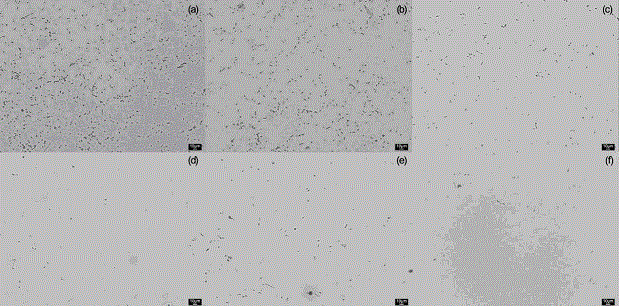Antifouling coating material based on amphiphilic sol and preparation method for antifouling coating material
An anti-fouling coating and coating material technology, applied in the direction of coating, can solve the problems of difficult synthesis technology and screening, poor physical and chemical stability, complex process, etc., and achieve the effect of significant anti-protein adsorption.
- Summary
- Abstract
- Description
- Claims
- Application Information
AI Technical Summary
Problems solved by technology
Method used
Image
Examples
Embodiment 1
[0029] In a three-necked flask equipped with a stirrer, a thermometer, and a dropping funnel, add 30g of octyltrimethoxysilane, 48g of ethyl orthosilicate, 22g of octadecyltrimethoxysilane, and 15g of polyethylene glycol siloxane , 20g of silica sol, 100g of absolute ethanol, 10g of hydrochloric acid, and 10g of deionized water were heated to 50°C, kept at reflux and stirred for 12 hours, and cooled to obtain an amphiphilic sol. The sol is uniformly mixed with fillers, resins, additives and other components to prepare a coating. Among them, amphiphilic sol accounted for 35 wt%, dihydroxy-terminated polydimethylsiloxane 7 wt%, silica powder 15 wt%, titanium dioxide powder 3 wt%, diluent 36 wt%, catalyst 3 wt% %, leveling agent 1wt%, the coating is cured at 30 ℃ to form a film.
Embodiment 2
[0031] In a three-necked flask equipped with a stirrer, a thermometer, and a dropping funnel, add 50g of tetraethyl orthosilicate, 16g of hexadecyltrimethoxysilane, 25g of methyltrimethoxysilane, and 10g of polyethylene glycol siloxane , 15g of zirconia sol, 100g of absolute ethanol, 10g of deionized water and 5g of tetraethyl titanate, the temperature was controlled to 30°C, kept at reflux and stirred for 48 hours, then cooled to obtain the sol. The sol is mixed with a diluent, a leveling agent, etc. to prepare a coating material. Among them, the amphiphilic sol accounts for 30wt%, diluent 38wt%, ferric oxide powder 10wt%, leveling agent 2wt%, and the coating is cured at room temperature to form a film coating.
Embodiment 3
[0033] In a three-necked flask equipped with a stirrer, a thermometer, and a dropping funnel, add 30 g of methyl orthosilicate, 10 g of isobutyltrimethoxysilane, 23 g of dodecyltrichlorosilane, and 5 g of polyethylene glycol under nitrogen. Siloxane, 27g ZrCl4, 70g absolute ethanol, 15g deionized water and 3g nitric acid were heated up to 40°C while stirring, kept at reflux and stirred for 18 hours to obtain a sol. The sol is mixed with organic fluorosilicone resin, diluent, catalyst, cross-linking agent and leveling agent to prepare coating. Among them, the sol accounts for 30wt%, organic fluorine-silicone resin 20wt%, diluent 30wt%, catalyst 1wt%, crosslinking agent 2wt%, ferric oxide powder 5wt%, zirconia powder 10wt% %, leveling agent 2 wt%, the coating is cured at room temperature to form a film coating.
PUM
 Login to View More
Login to View More Abstract
Description
Claims
Application Information
 Login to View More
Login to View More - R&D
- Intellectual Property
- Life Sciences
- Materials
- Tech Scout
- Unparalleled Data Quality
- Higher Quality Content
- 60% Fewer Hallucinations
Browse by: Latest US Patents, China's latest patents, Technical Efficacy Thesaurus, Application Domain, Technology Topic, Popular Technical Reports.
© 2025 PatSnap. All rights reserved.Legal|Privacy policy|Modern Slavery Act Transparency Statement|Sitemap|About US| Contact US: help@patsnap.com


